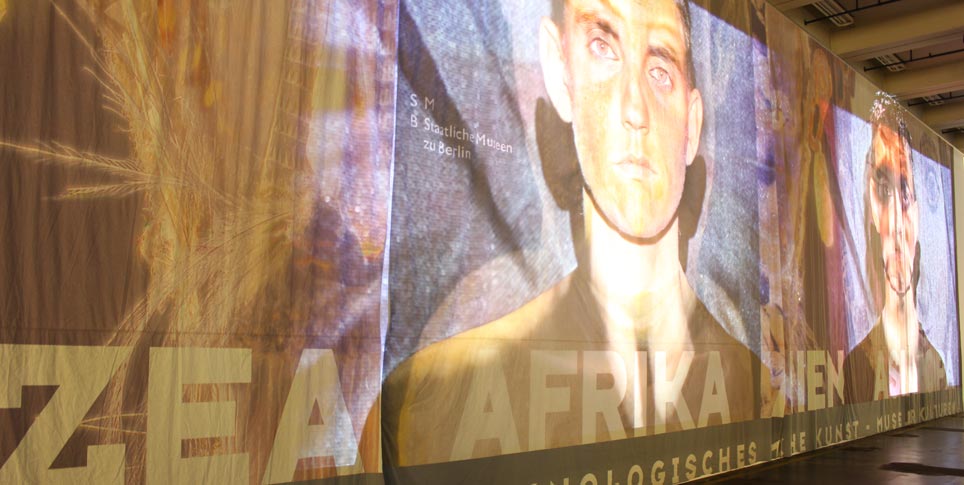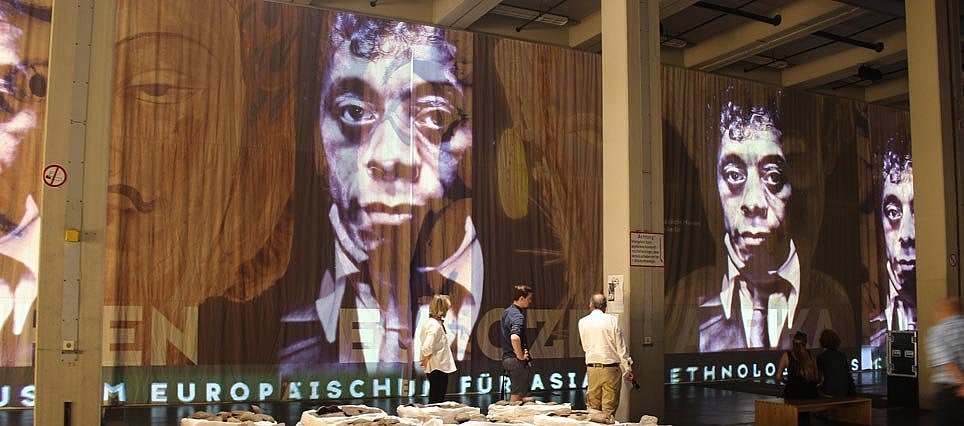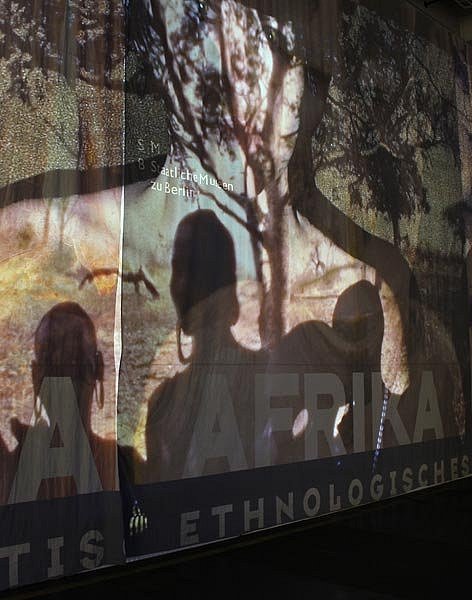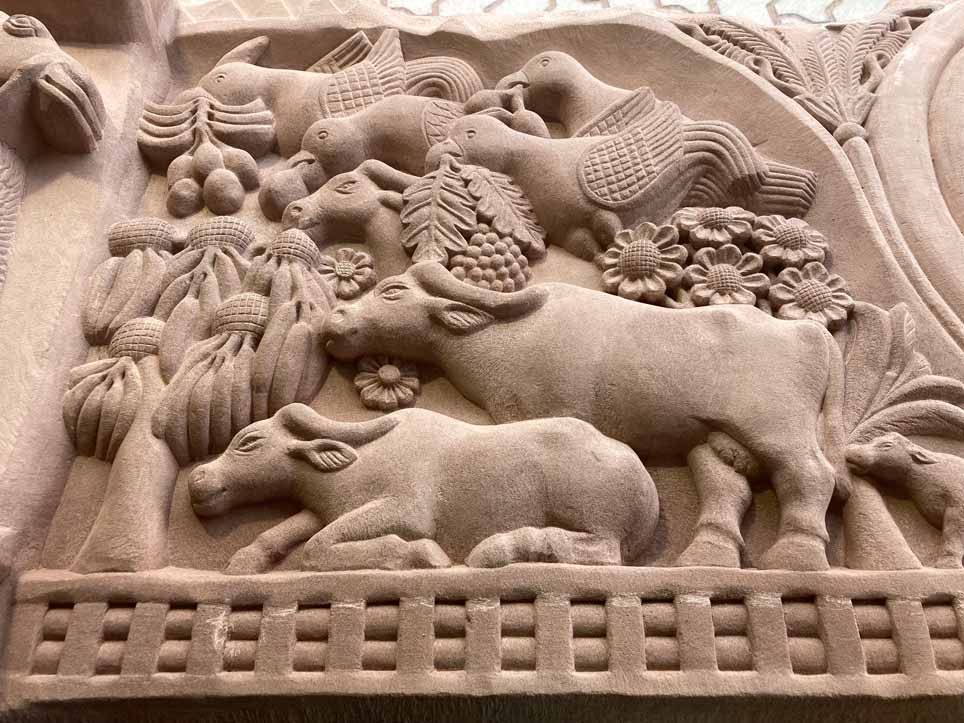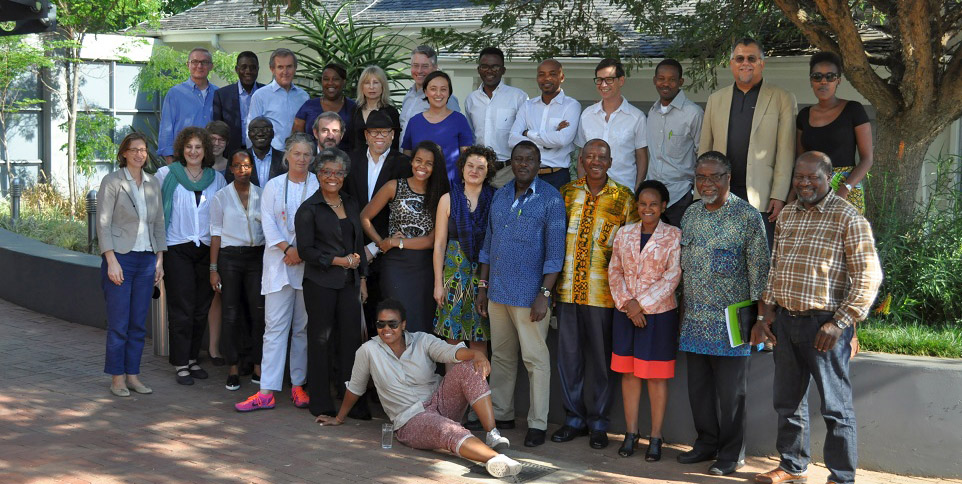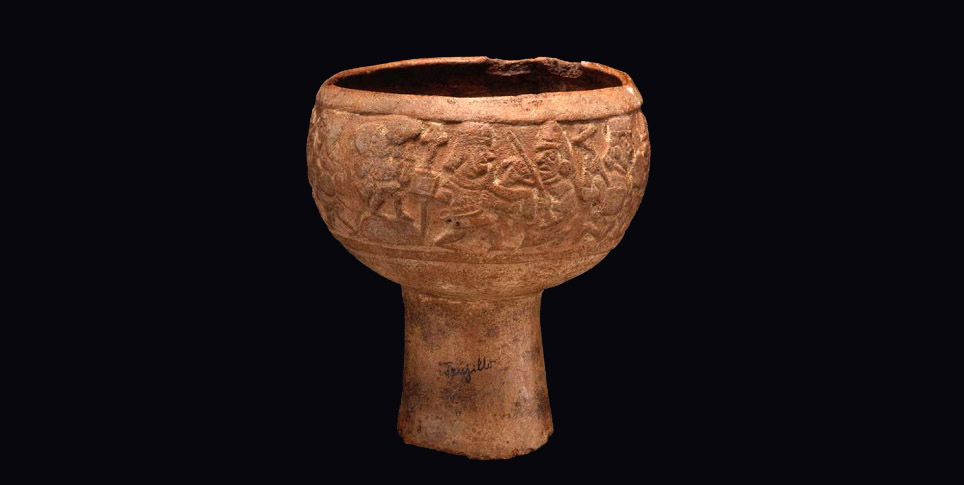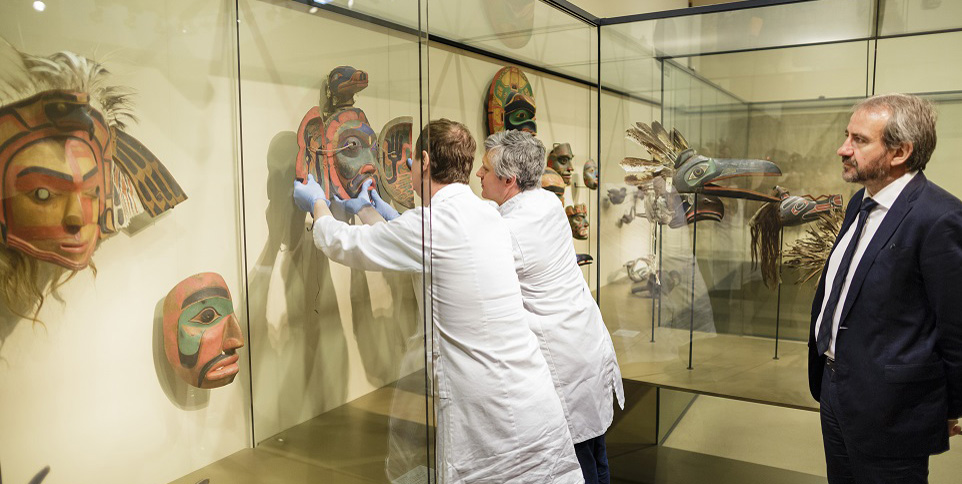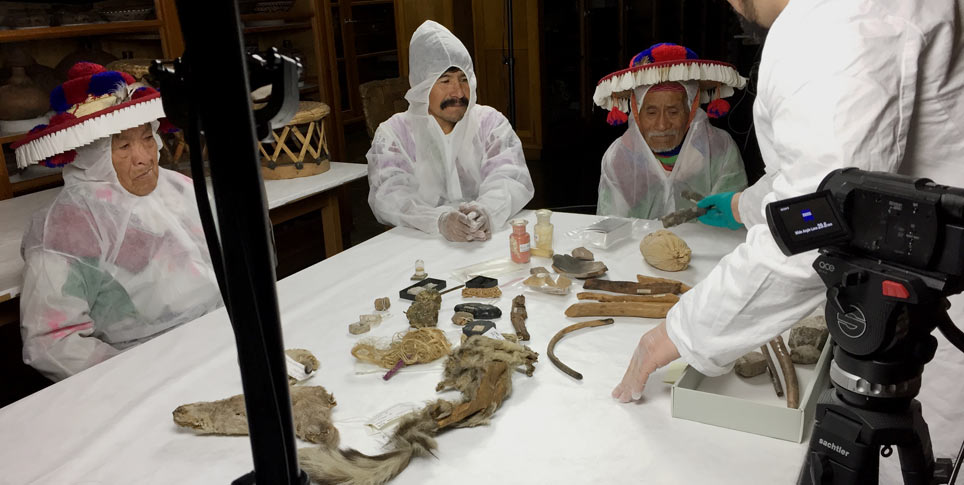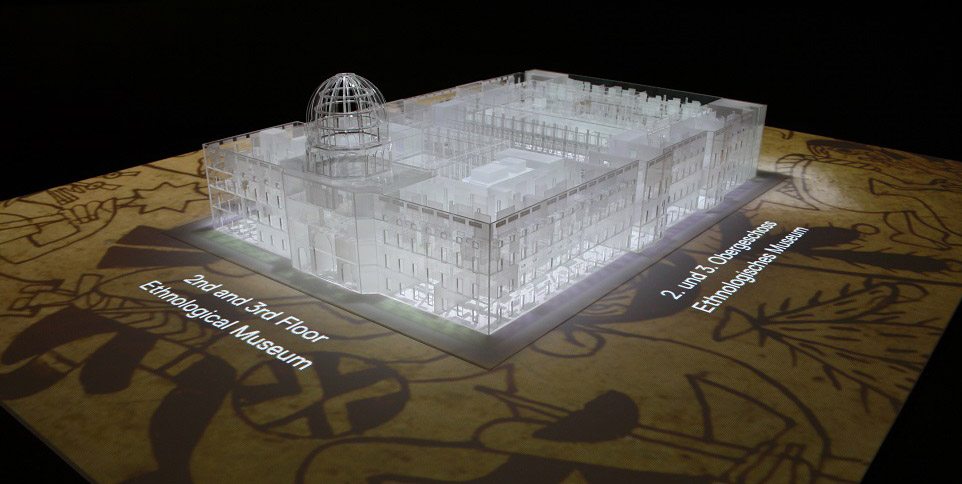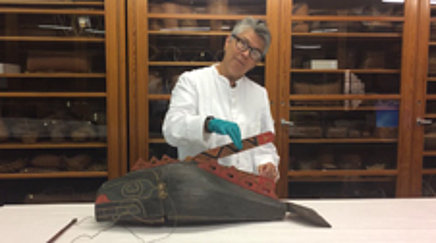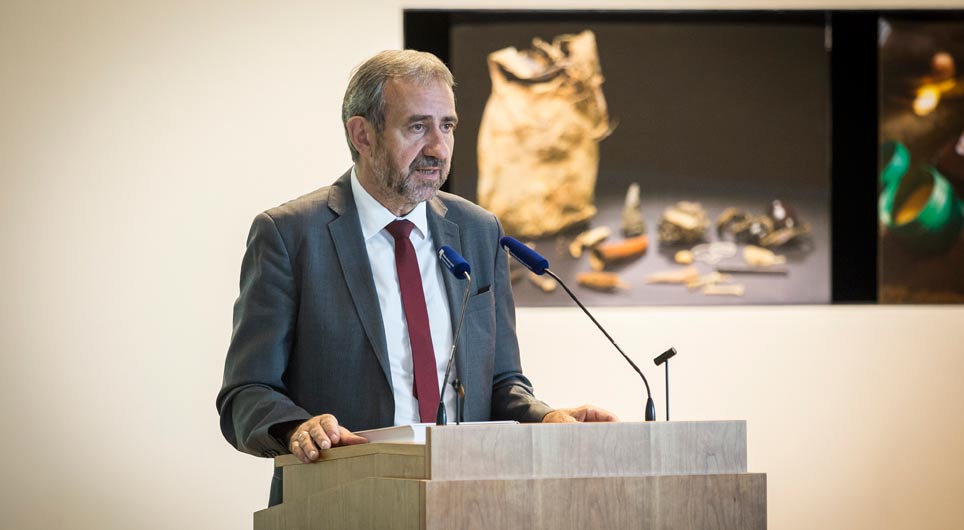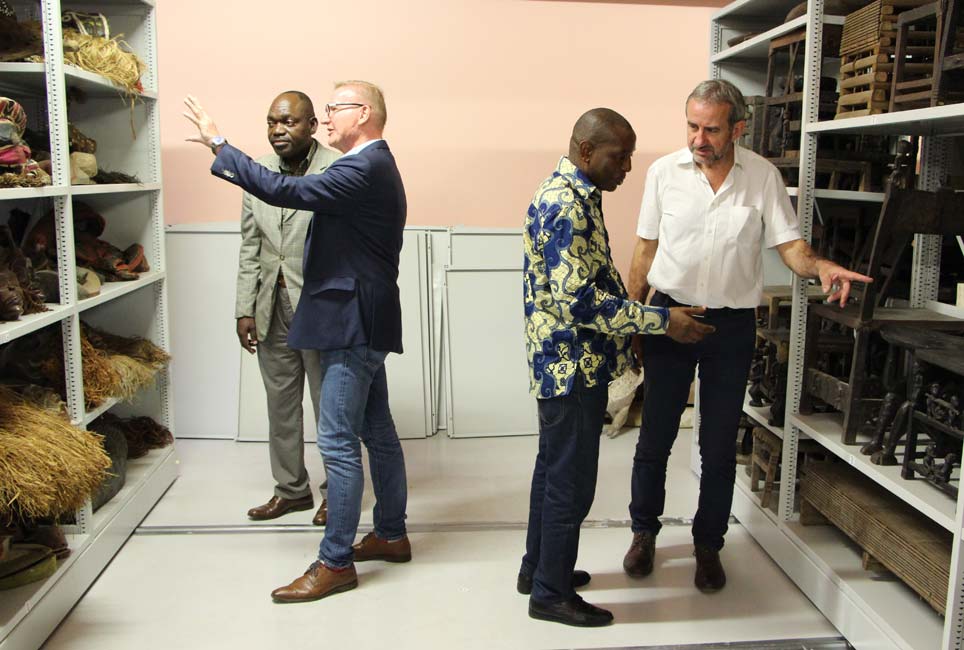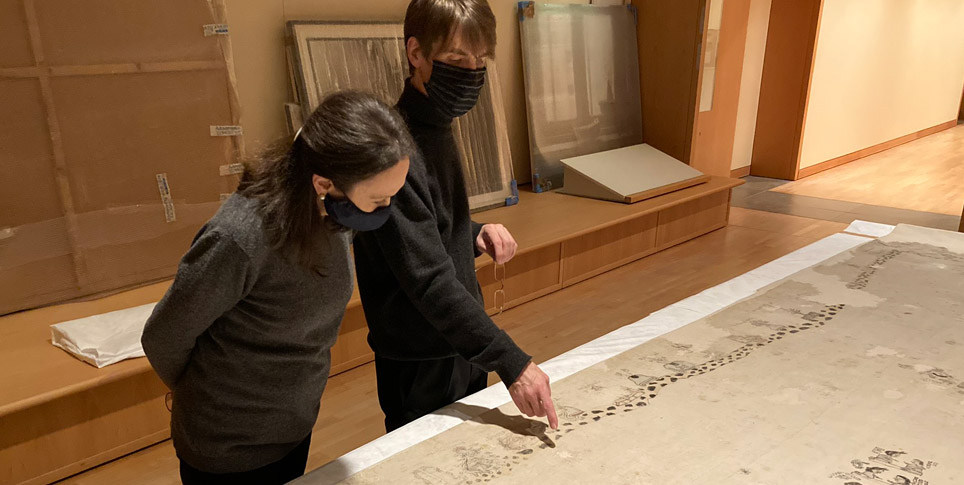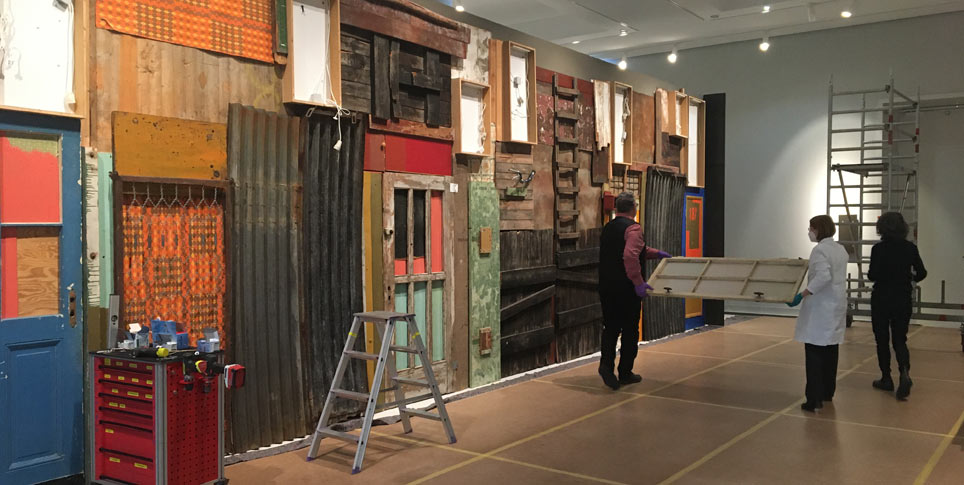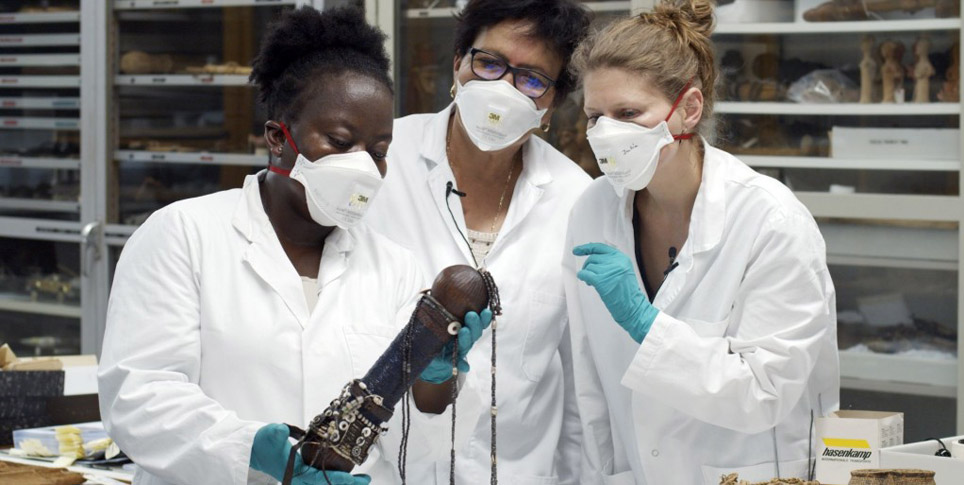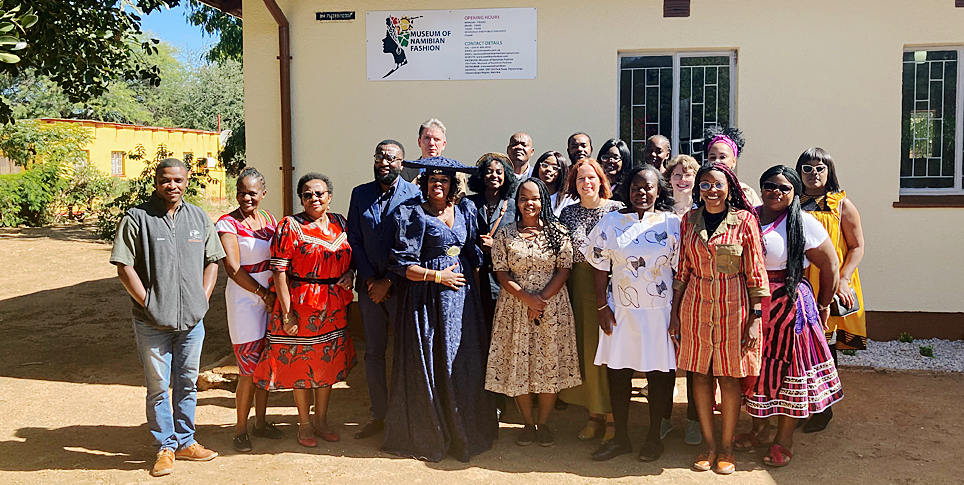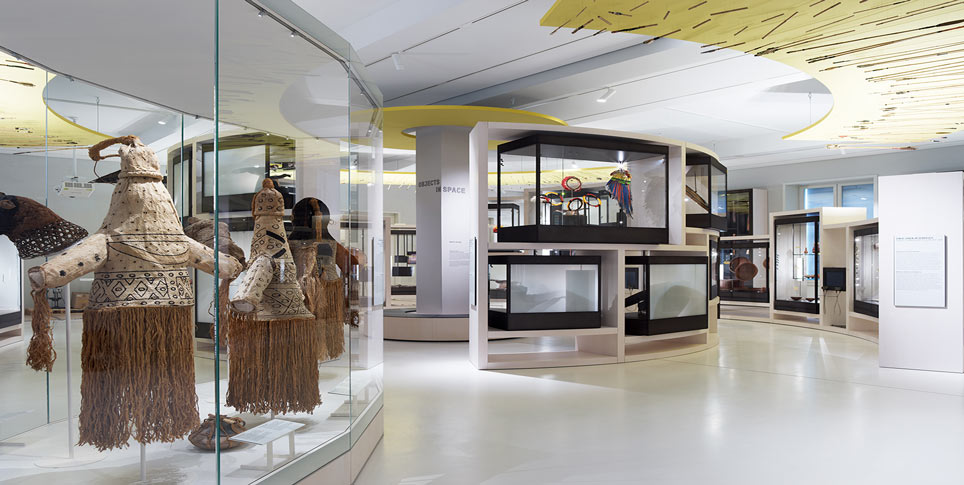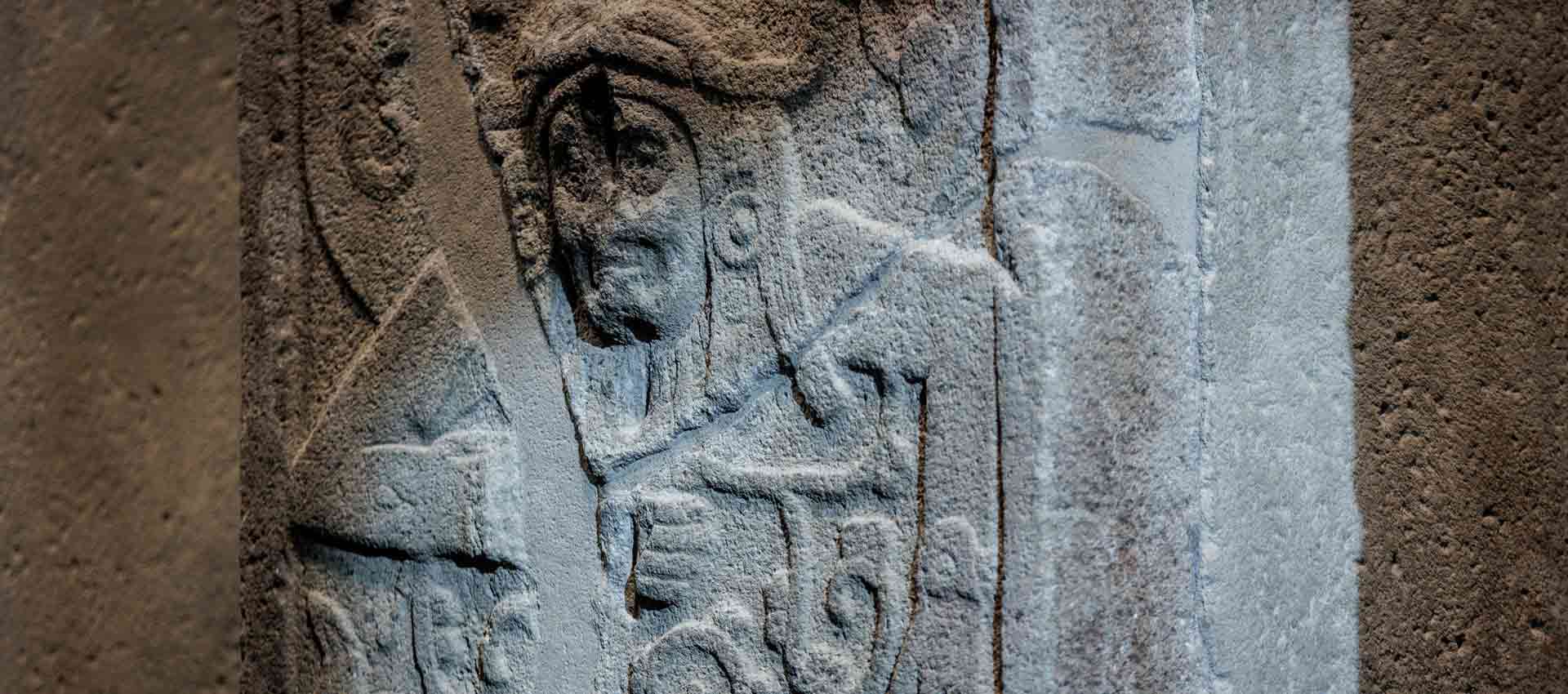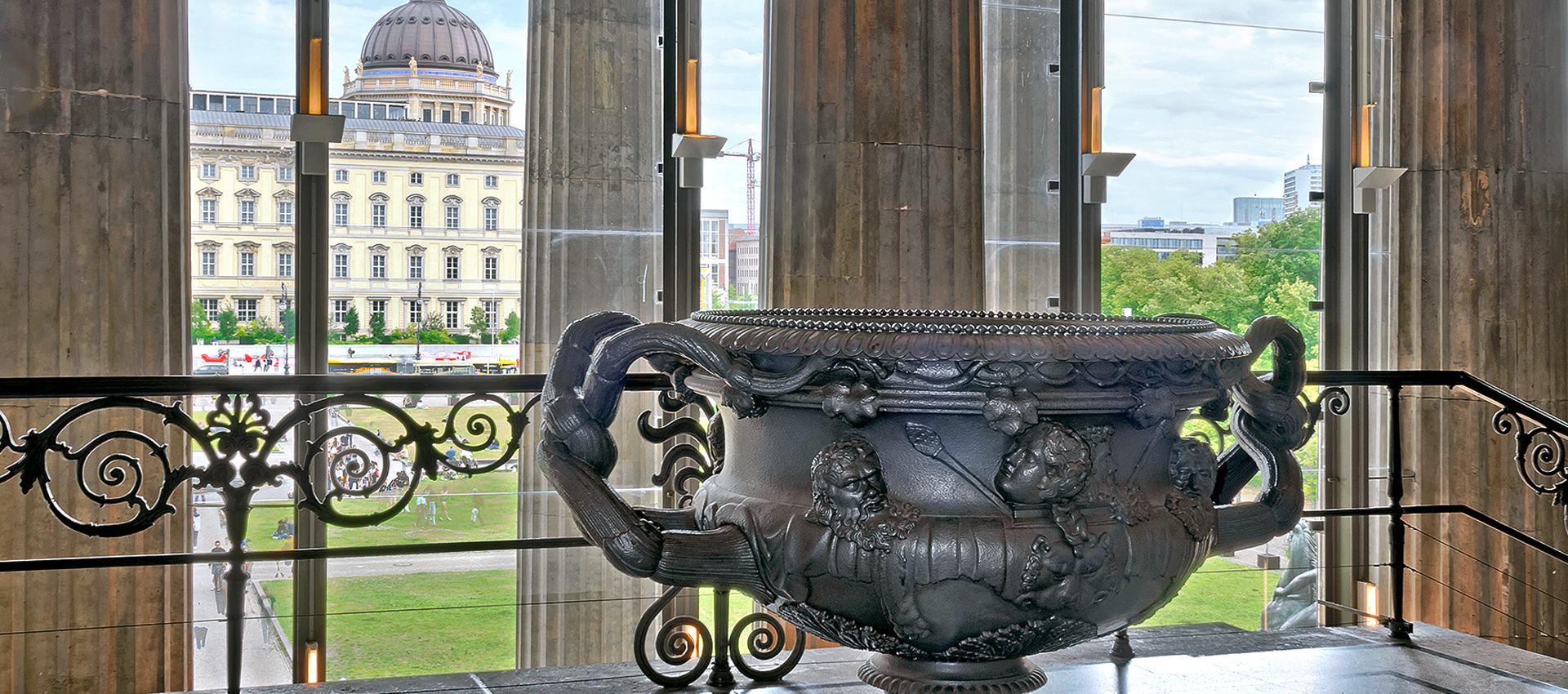Video artist Theo Eshetu has been following the move of the Dahlem museums into the Humboldt-Forum for a documentary film he is making. At documenta 14, he is showing Atlas Fractured, an expansive installation that projects video onto a banner which originally hung over the entrance to the Dahlem museums. Julia Lerche and Stefan Müchler speak with Theo Eshetu about how the piece was created, about fragmented identities, and about big words in small wall texts.
How was your documenta14 project “Atlas Fractured” developed?
While filming in the museums workmen were cutting a banner that traditionally for many years had decorated the Ethnographic Museum. And when I asked the workmen what they were doing with the banner they said they were throwing it away. And so I said, “Do you mind if I keep it”, and they said, “You’re doing us a favor if you help us get rid of it”. So that was something that I did spontaneously without really thinking where, how, or what was going to happen with it. When I was invited for documenta14 it occurred to me that it might be one of the rare opportunities to be able to remount the Dahlem banner and to use it as a kind of cinema screen onto which to make other projections. So the whole idea for “Atlas Fractured” started actually with a reflection on what the banner is, what it represented. It represents five continents through the image of masks. So what are the masks for today? How can the world be represented today?
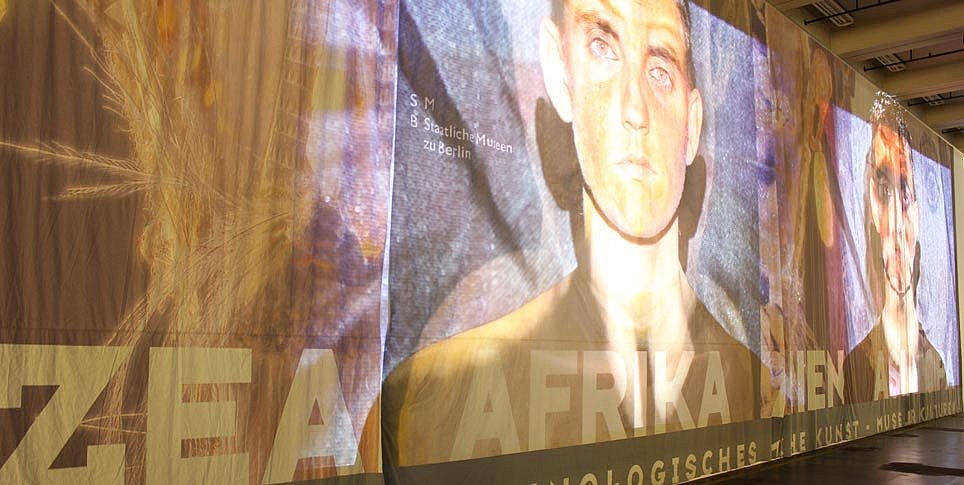
© SPK / Theo Eshetu / Stefan Müchler
For those who don’t have the opportunity to visit documenta14. Could you explain “Atlas Fractured”? What is it all about?
There is a visual effect that I have used for quite a number of years and that is to project images on peoples’ faces, to project a face on a face. I could project your face onto my face and then we have a kind of neither my face nor your face. We have something else. So what I’ve done is I’ve invited quite a few people – male, female, black, white… – to come to my studio and we kind of improvised a whole series of projections on their face. Those projections might have been of cultural objects. They might have been of paintings. They might even be films. And through that collection of images projected on peoples’ faces I kind of created maybe a history of representation. Although that doesn’t even explain it. The curious thing about is that you’re aware that you’re seeing a still image and at the same time you’re aware that it’s a living image, because the eyes are alive. That combination creates both a grotesque and a beautiful combination. So that’s what you see.
So despite our diversities and despite our cultural differences at a kind of a deeper lever, we’re in a sense made of the same flesh and blood.
What’s the message of your artwork and is there a link to the Humboldt Forum?
There is, I would say, maybe a conceptual link to the Humboldt Forum. In other words, the Humboldt Forum, I believe, is a kind of project where identities are being defined. In terms of a national German identity to one extend and with the move of the Ethnographic Museum and the Museum of Asian Art a reflection also on a global identity. How these two forms of identity can dialogue with each other – both a national one and a global one. And its message, I’m not sure, if it has a message. But its message is, well, that in the end of the day, as it says in the video by quoting a poem by Maya Angelou: “We are more alike, my friends, than we are unalike”. So despite our diversities and despite our cultural differences at a kind of a deeper lever, we’re in a sense made of the same flesh and blood.
In the Neue Neue Galerie in Kassel visitors can’t see your installation “Atlas Fractured” as a whole. The perception is kind of fractured, too. Did you plan this or did it just happen?
Because of the sheer size of the banner – it’s about 38m long by 7m high – it wasn’t easy to find an appropriate space. It was important for me to have a space that was indoors in order for there to be a kind of a surprise element of the outdoor object which comes indoors. And I wanted to use it as a screen with which the images dialogue. Because of the columns in the room and the small distance I actually spent a week to ten days reediting the video for the vision in Kassel. So now you could not have a full vision but you’re invited to walk around. I like this idea that the installation invites you to move and not sit like in a cinema.
You just mentioned the enormous dimensions of the banner. How you actually picked it up and get it to your studio?
While I had come to Dahlem to film the Berlin Biennale that was taking place there, they had cut the banner to put the Berlin Biennale banner up. Originally I was only going to take the part that said “Africa”. So I folded “Africa” and I thought I could carry this afterwards. Because a lot of my work is about the dialogue between cultures, I asked the workmen if it would be possible to take “Europe” as well. And they said: “Sure, you can take Europe. In fact if you want to you can take the whole world. You would do us a favor.” So I thought it was not a bad idea to take over the whole world. (Laughing) I phoned a friend for help. It stayed in my kitchen for four days. Then I found someone with a cellar. It stayed there for almost eight months before I was invited to documenta14 and managed to propose it as an idea.
Did you cut it further?
No, I made sure I didn’t apply any cuts myself. Interesting about this is that all the continents are slightly cut in their face except for Africa which is the only one that’s whole. Another little remarkable coincidence is that in the Neue Neue Galerie the height of the building is exactly 6.60m high, just exactly the same height as the banner.
So you arranged those pieces of the banner in a new way?
Originally the banner represented the world, it represented wholeness. I was interested the minimal intervention to rearrange it. The concept is: How can the world be rearranged? How can we make it a different world form what it is? How can the fractures that we feel that exist in the world today be somehow represented in a kind of truthful way? If identities are no longer clearly defined, how can this new identity be represented? That is represented with the video images and I thought it would be interesting to also put the banner in a wrong order as it was. So it would also represent a fractured world or a world that’s being repieced together.
There is a very special repiecement. You arranged Asien and Europa in a new way which means “Asiropa”. Was it intended, because it has a little play on words?
Yes, absolutely. It’s remarkable, because I mentioned earlier there were no additional cuts made. So it’s very interesting that these places got renamed and have another kind of meaning now. After all, if you say “Asien” to someone, who has never been to Asia, they probably have a stereotype image. Whereas if you invent a new word, that really opens the imagination.
How did you pick your quotes, which are used in the video or the characters?
I was trying both with the images and the sound to define something that I felt about this representation of a fractured atlas. So I rather instinctively selected a group of words, a group of interviews with different people, psychologists, writers, poets, filmmakers, people that study myths and musicians. This series of phrases is for me an interesting way of understanding the world. It is an interesting reading of the world and the way we are in it.
Has your documentary on the Dahlem Museums and their movement to the Humboldt-Forum had some influence on your installation?
I am interested in that dialogue between what the Humboldt Forum is becoming and what the Ethnological Museum was. But I am not interested in coming up with some kind of solution for it, whatever the problem might be. Therefore the documenta project is a part of a reflection. You could say it is a German story or a Berlin story, which of course it is. But for me it also has kind of biographical residences, because I am partially African and partially European. So in a sense this dialogue between cultures and between my own sense of identity is a very strong driving force to inquire and be interested in this subject matter.
I am not interested in coming up with some kind of solution for it, whatever the problem might be.
The wall text describing your artwork is really critical regarding the Humboldt Forum. Is this a joint text, where you involved in it?
Originally I didn’t want a wall text because I believed and still believe that my work speaks for itself. But then it was correctly suggested that a lot of the viewers would not know where the banner comes from and that some information might be useful. In my opinion a critical aspect of the text is that it naturally assumes the Humboldt Forum to be polemical without qualifying why. Another statement I thought was odd is the claim that I was attempting to create a “New World Order”. That’s really far from what I wanted to do even though it's placed in inverted commas. I think what the work might represent is an Old World Disorder or poetically express the fractures of the present. I'm sure that people looking at the video will feel the underlying message and realize what the work is about.
